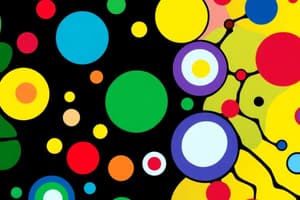Podcast
Questions and Answers
List the 3 parts of the Cell Theory.
List the 3 parts of the Cell Theory.
- All cells come from existing cells. 2. Cell is the basic unit of all living things. 3. All organisms are composed of 1 or more cells.
What is the benefit of a scanning electron microscope over a light microscope?
What is the benefit of a scanning electron microscope over a light microscope?
Highly magnified images
What is the composition of the cell membrane?
What is the composition of the cell membrane?
Double layered lipid bilayer.
List the organization of life from least complex to most complex.
List the organization of life from least complex to most complex.
What are organs made of?
What are organs made of?
What system works together to maintain homeostasis in the body? (Select all that apply)
What system works together to maintain homeostasis in the body? (Select all that apply)
What is the shape of red blood cells?
What is the shape of red blood cells?
How do red blood cells help maintain homeostasis in your body?
How do red blood cells help maintain homeostasis in your body?
What is the function of white blood cells?
What is the function of white blood cells?
What organelles would you expect to find in large numbers so antibodies can be synthesized?
What organelles would you expect to find in large numbers so antibodies can be synthesized?
Why is the vacuole in a plant cell so large?
Why is the vacuole in a plant cell so large?
List 3 structures that differ in plant and animal cells.
List 3 structures that differ in plant and animal cells.
What microscope can produce 3-dimensional images?
What microscope can produce 3-dimensional images?
List 2 types of active transport.
List 2 types of active transport.
What is the function of lysosomes?
What is the function of lysosomes?
Flashcards are hidden until you start studying
Study Notes
Cell Theory
- All cells arise from existing cells, emphasizing the continuity of life.
- Cells serve as the fundamental unit of structure and function in all living organisms.
- Every organism is composed of one or more cells, highlighting cell diversity.
Microscopes
- Scanning electron microscopes (SEM) provide highly magnified 3-dimensional images, surpassing the capabilities of light microscopes.
Cell Membrane Structure
- The cell membrane comprises a double-layered lipid bilayer, lending it flexibility and structural integrity.
Levels of Biological Organization
- Life structures are organized from smallest to largest: Cell, Tissue, Organ, Organ System, Organism.
Organ Composition
- Organs are constructed from multiple types of similar tissues which work together to perform specific functions.
Homeostasis Systems
- The body maintains homeostasis through various systems including but not limited to the digestive, circulatory, immune, and endocrine systems.
Red Blood Cells
- Red blood cells have a concave shape, which aids in efficiently transporting oxygen throughout the body, supporting homeostasis.
White Blood Cells
- White blood cells function primarily in fighting infections, with a significant presence of rough endoplasmic reticulum for antibody synthesis.
Plant Cell Vacuoles
- Plant cells feature large vacuoles filled with fluid, which help maintain turgor pressure, supporting leaves and flowers.
Differences Between Plant and Animal Cells
- Key structural differences include the presence of chloroplasts, centrosomes (centrioles), and a cell wall in plant cells, which are absent in animal cells.
Types of Microscopy
- Scanning electron microscopes are notable for their ability to produce detailed three-dimensional images of specimens.
Active Transport Mechanisms
- Two forms of active transport are:
- Molecular transport: involves protein pumps that move small molecules across membranes.
- Bulk transport: facilitates the movement of large molecules into or out of cells.
Lysosomes
- Lysosomes serve crucial roles in breaking down and recycling macromolecules, contributing to cellular maintenance and waste management.
Studying That Suits You
Use AI to generate personalized quizzes and flashcards to suit your learning preferences.




